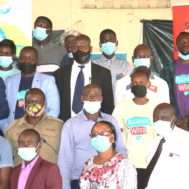As we celebrate the International Day of the Girl Child 2022, under the theme: “Our time is now – our rights, our future” research released by UNFPA, the UN sexual and reproductive health agency, reveals that nearly a third of all women in developing countries begin childbearing at age 18 or younger, and nearly half of first births to adolescents are to children or girls aged 16 or younger.
While global fertility has declined, the UNFPA data showed that women who began childbearing in adolescence had almost 5 births, with Uganda having 4.8 by the time they turned 40 in 2020.
“When nearly a third of all women in Uganda are becoming mothers during adolescence, it is clear the country is unknowingly ruining the future of adolescent girls,” said Dr. Peter Ibembe, Reproductive Health Uganda (RHU) Director of Programs.
“The repeat pregnancies we see among adolescent mothers are a glaring signpost that they desperately need sexual and reproductive health information and services” said Bishop Kipto Masaba of Sebei Diocese.
This is evident in the Butaleja district, where Uganda’s youngest grandma, aged 27, was born in 2021.
Additional childbirth in adolescence is frequent among child moms after having their first kid. Nearly three-quarters of females who have their first child at the age of 14 or less have a second child in adolescence, and 40% of those who have two children have a third before leaving adolescence.
Giving birth complications are a primary cause of mortality, 368 deaths per 100,000 in Uganda (UBOS,2021) and injury among teenage girls, but being an adolescent mother may also result in grave abuses of their human rights and serious societal implications, such as child marriage, intimate-partner violence, and mental health concerns. The youngest child mothers face the most dangers.
There is positive evidence of decreased levels of motherhood in childhood and adolescence over the world. However, the rate of reduction has been frighteningly sluggish, frequently falling by barely three percentage points every decade.
“Governments need to invest in adolescent girls and help expand their opportunities, resources, and skillsets, thereby helping avoid early and unintended pregnancies,” said UNFPA Executive Director Dr. Natalia Kanem. “When girls can meaningfully chart their own life course, motherhood in childhood will grow increasingly rare.”
The report makes policymakers recommendations such as providing comprehensive sexuality education, mentorship, social support, and quality health services to girls, as well as providing economic support to families and engaging local organizations, all within a supportive policy and legal framework that recognizes the rights, capacities, and needs of adolescents, particularly marginalized adolescent girls.
We think, in collaboration with our partners, that girls are ready for a lifetime of rapid progress. It is time for all of us to take responsibility – with and for girls – and invest in a future that values their agency, leadership, and potential.
A call to action
From October 2022 through October 2023, we will urge for increased focus, investment, and action on:
- Supporting teenage girls’ leadership at the forefront of change initiatives, including hearing their views, responding to their requests, and creating places for their involvement in decision-making
- Increasing resources and investments in teenage females, including networks and organizations that advocate for excellent, inclusive education and promote their well-being
- Improving access to and utilization of inclusive teenage girl-centered services at all times, but particularly during crisis response and recovery
The writer of this article Aldon Walukamba is the Media Advocacy and Documentation Coordinator at Reproductive Health Uganda


